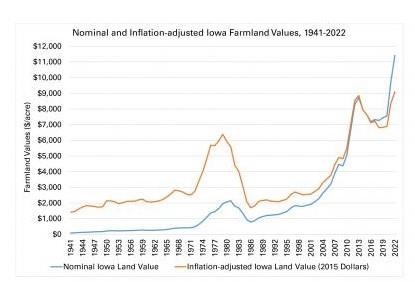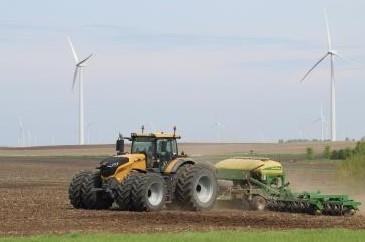By Wendong Zhang and Nathan Cook
One year after skyrocketing 29%, the average value of an acre of Iowa farmland jumped another 17%, or $1,660, to $11,411 per acre. The nominal value of an acre of farmland is again higher this year than at any point since Iowa State University began surveying values in 1941. When adjusting for inflation, the 2022 average value surpasses the previous inflation-adjusted record value set in 2013 for the first time.
Farmland values in Iowa have increased more than 15% in a year a handful of times since 1941, most notably in 2011, when values rose 32.5%, and last year, when values rose 29%.
While inflation was a major factor that drove the increase last year, Wendong Zhang, an associate professor of economics and faculty affiliate of Center for Agricultural and Rural Development at Iowa State University, said that it did not play as much of a factor as commodity prices, limited land supply, and low interest rates through summer 2022 did this year.

Zhang, who is responsible for conducting the annual survey, said that inflation rates this year are similar to those from last year, but the Federal Reserve has used aggressive rate hikes since this summer to curb the problem. “The Federal Reserve seems to be determined to keep raising interest rates until they get a firm control on inflation. This is a tricky balance because larger and quicker interest rate hikes run the risk of slowing down the economy, potentially to a recession,” Zhang said. While he noted that higher interest rates put downward pressure on the land market, the effects typically don’t show up in land prices for one or two years.
While the Federal Reserve has been raising interest rates, Zhang said that 81% of Iowa farmland is fully paid for, so the higher interest rates don’t always affect farmers’ land purchasing decisions. This is especially true when high inflation makes the real interest rates negative or low, which tends to incentivize more borrowing and investment. Furthermore, a significant portion of respondents said that cash on hand was a positive factor influencing land values. “Farmers have a lot more cash on hand and supply chain issues led to a shortage of equipment, so the money that farmers normally spend on equipment is now devoted to land,” he said.
As for commodity prices, Zhang said they have been strong this year and yields have been higher than expected, despite the weather challenges. “Not only are crop prices much higher, livestock and poultry prices are also significantly higher, translating into higher farm income and profits,” he said.
For the first time, this year’s survey asked respondents’ views of current farmland values. Zhang said that 70% of respondents feel that current land values are too high or way too high.
“The higher land values do create an even higher entry barrier for beginning farmers, and the following increase in cash rents along with higher input costs could negatively affect producers, especially those with a lot of rented ground,” he said.

Zhang said that 48% of respondents forecasted an increase in farmland values one year from now, while 24% forecasted no change and 28% expected lower values. He said that most respondents expect the one-year value to either be the same or increase roughly 5–10%.
Looking five years ahead, Zhang said that 60% of respondents believe land values will increase 10–20% from current values, while about 24% forecast a decline in prices.
Land Values by County
For the second year in a row, all 99 of Iowa’s counties showed an increase in land values. However, for the first time in almost a decade, Scott County did not report the highest overall value. O’Brien County topped the list this year, reporting a 20.6% increase, or $2,818 per acre, to $16,531. Decatur County again reported the lowest value, though land values there increased 10%, or $505 per acre, to $5,566.
Mills, Fremont, Page and Montgomery counties reported the largest percentage increase, 21.6%, while O’Brien County saw the largest dollar increase, $2,818 per acre. Wayne, Lucas, Appanoose, and Decatur counties saw the smallest percentage increase, 10%, while Decatur County saw the smallest dollar increase, $505 per acre.
Land Values by District
Land values increased across all crop reporting districts. The Northwest district reported the highest overall value, $14,878 per acre, the largest percentage increase, 22.3%, and the largest dollar increase, $2,714 per acre.
The South Central district reported the lowest values, $6,824 per acre, and the lowest dollar change, $790 per acre, while the Southeast district saw the smallest percentage increase, 9.8%.
Land Values by Quality
Statewide, low-quality land now averages $7,369 per acre, an increase of 15.2% or $972 per acre. Medium-quality land now averages $10,673 per acre, an increase of 17.7% or $1,602 per acre. High-quality land now averages $13,817 per acre, an increase of 16.8% or $1,983 per acre.
The Northwest district reported the highest values for low-, medium-, and high-quality land at $9,569, $13,710, and $17,121 per acre, respectively. The South Central district reported the lowest values for low-, medium-, and high-quality land at $4,379, $6,872, and $9,478 per acre, respectively.
Low-quality land saw the largest percent increase in the Northeast district, 19.8%, while the Northwest district saw the largest dollar increase, $1,481 per acre. Low-quality land saw the smallest percent increase, 7.9%, and the lowest dollar increase, $321 per acre, in the South Central district.
Medium-quality land saw increases of more than 20% in the West Central, Northeast, Southwest, and Northwest districts, which respectively showed increases of 20.1%, 21.9%, 22.7%, and 24.2%. The Northwest district also saw the largest dollar increase in medium-quality land, $2,688 per acre. The Southeast district showed the lowest percent increase in medium-quality land, 6.2%, and the lowest dollar increase, $508 per acre.
High-quality land in the West Central, Southwest, and Northwest districts all saw increases of more than 20% — 20.6%, 21.2%, and 22.3%, respectively. The Northwest district reported the largest dollar increase in high-quality land at $3,124 per acre. The Southeast district reported the smallest percent change in high-quality land, 10.3%, and the smallest dollar increase, $1,201 per acre.
Factors Influencing the Land Market
The most frequently mentioned positive factor influencing the land market was higher commodity prices. Limited land supply and low interest rates through summer 2022 were the second- and third-most frequently mentioned factors. Other frequently mentioned factors included cash on hand and high credit availability, strong yields, a good farm economy and strong demand.
The most frequently mentioned negative factor affecting land values was interest rate hikes. Other noted factors included concerns about higher input costs, and stock market volatility and economic uncertainty were the second- and third-most frequently mentioned negative factors.
Land values were determined by the 2022 Iowa State University Land Value Survey, conducted in November by the Center for Agricultural and Rural Development at Iowa State and Iowa State University Extension and Outreach. Results from the survey are consistent with results by the Federal Reserve Bank of Chicago, the REALTORS Land Institute, and the U.S. Department of Agriculture.
The Iowa State Land Value Survey is based on reports by agricultural professionals knowledgeable of land market conditions, such as appraisers, farm managers, agricultural lenders, and actual land sales, and is intended to provide information on general land value trends, geographical land price relationships and factors influencing the Iowa land market. The 2022 survey is based on 668 usable responses from 443 agricultural professionals. Seventy-one percent of the 443 respondents answered the survey online.
The Iowa State Land Value Survey was initiated in 1941, the first in the nation, and is sponsored annually by Iowa State. The survey is typically conducted every November and the results are released mid-December. Only the state average and the district averages are based directly on the Iowa State survey data. County estimates are derived using a procedure that combines the Iowa State survey results with data from the U.S. Census of Agriculture.
CARD offers a web portal at https://www.card.iastate.edu/farmland/ that includes visualization tools, such as charts and interactive county maps, allowing users to examine land value trends over time at the county, district, and state level.
For over 60 years, the Center for Agricultural and Rural Development at Iowa State University has conducted innovative public policy and economic research on local, regional and global agricultural issues, combining academic excellence with engagement and anticipatory thinking to inform and benefit society.
Source : iastate.edu